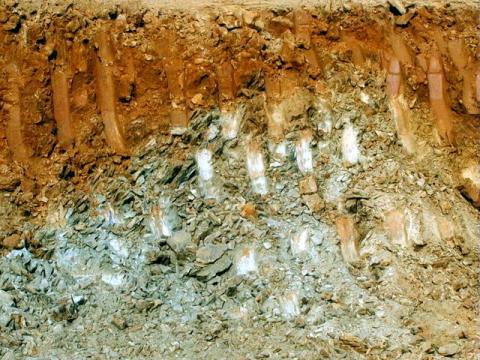
If you’re in charge of a workplace, you’re required by law to have an asbestos management plan in place, unless your premises were constructed after 31 December 2003 or the presence of asbestos has been ruled out by a comprehensive asbestos survey.
About naturally occurring asbestos (NOA)
We normally think about asbestos in its processed form, and expect to encounter it as a result of contamination from its use as a building material.
However, asbestos is a naturally occurring substance, so although it’s not an everyday occurrence, it’s still possible to encounter it in its natural form, in rock, sediment or soil.
A project was undertaken by the Geological Survey of NSW to map all known and potential naturally occurring asbestos sites in the state, identifying areas with low, medium and high potential for asbestos to be present. Since 2015, the resulting data has been available via an online map.
Should I be concerned about naturally occurring asbestos?
Thanks to the availability of mapping data, it’s possible to check, before undertaking an activity, whether you are going to be in an area with potential for naturally occurring asbestos. If so, you can take some precautions to reduce your chance of exposure.
In particular, precautions should be taken by people living, farming or organising recreational activities in areas of risk, and SafeWork NSW has published recommendations for each of these groups.
People living in areas of naturally occurring asbestos can take measures to exclude dust from their homes, such as cleaning with wet cloths and mops, regularly washing items that might collect dust, and closing windows on windy days. They can also take precautions outside, such as not using leaf blowers, and sealing driveways and pathways to minimise dust.
People farming in areas of naturally occurring asbestos can delay dust-generating activities on windy days, wet areas to minimise dust generation during activities that disturb soil like planting and digging, and use protective equipment when using heavy machinery.
Finally, people organising recreational activities in areas of naturally occurring asbestos can limit activities that generate dust, postpone or restrict activities on windy days, and discourage activities in areas of particularly high risk.
What’s an asbestos management plan?
An asbestos management plan — and its closely related document, an asbestos register — is vital for any organisation that’s at risk of asbestos contamination, however slight. But many organisations are confused about what these documents are for, and what they should consist of.
At its simplest, an asbestos register outlines where asbestos has been found in the workplace, while an asbestos management plan outlines the processes the organisation has in place for dealing with that asbestos.
The asbestos management plan must include:
- decisions, and reasons for the decisions, about the management of asbestos at the workplace, for example safe work procedures and control measures
- procedures for detailing accidents, incidents or emergencies of asbestos at the workplace
- workers carrying out work involving asbestos, for example consultation, information and training responsibilities
There are a variety of other elements that might be included in an asbestos management plan if they’re available and relevant. These include:
- an outline of how asbestos risks will be controlled
- a timetable for managing risks of exposure
- identification of individuals and their responsibilities
- procedures for reviewing the asbestos register and management plan
- air monitoring procedures at the workplace, if required
In other words, the asbestos management plan is a living document that should give a clear indication of what should happen in the case of any incidents that involve asbestos.
If you have any questions about asbestos risks or asbestos management plans, contact Airsafe on (02) 9555 9034. We’ll be happy to help.



